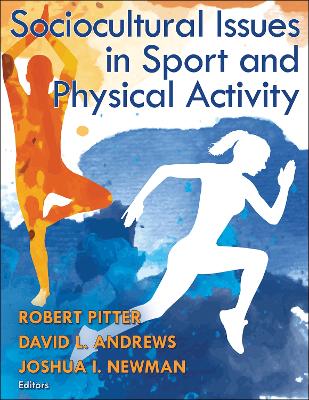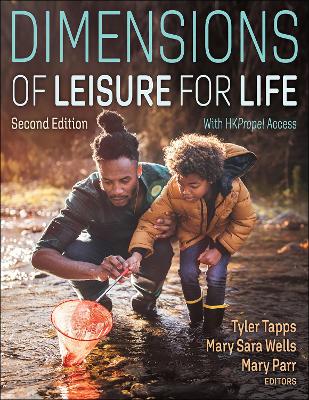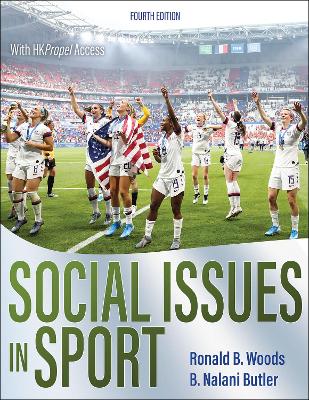Sociocultural Issues in Sport and Physical Activity
 -15%
portes grátis
-15%
portes grátis
Sociocultural Issues in Sport and Physical Activity
Pitter, Robert; Andrews, David L.; Newman, Joshua I.
Human Kinetics Publishers
05/2022
320
Mole
Inglês
9781450468657
15 a 20 dias
930
Descrição não disponível.
Part I. Body Institutions: Foundations and Considerations
Chapter 1. Introduction
Robert Pitter, David L. Andrews, and Brandon Wallace
Defining Physical Culture
Physical Culture and the Sociological Imagination
The Importance of a Critical and Theoretical Approach
Case Study: Fitness and Society
Conclusion
Chapter 2. Politics of the Active Body
Andrew Grainger, Brandon Wallace, and David L. Andrews
Politics as Power
Antonio Gramsci and Hegemony
Hegemony, Sport, and the Active Body
Dominant, Residual, and Emergent Forms of Physical Culture
Conclusion
Chapter 3. Critical Pedagogy and the Active Body
Ryan King-White and Matthew Hawzen
The Focus of Physical Education
Critical Pedagogy
Understanding and Applying Critical Pedagogy
Critical Pedagogy in Kinesiology
Conclusion
Chapter 4. Medicine, Technology, and the Active Body
Katelyn Esmonde
Physical Activity and Epidemiology
Physical Technocultures
Sociocultural Issues and Possibilities for Technologies of Physical Culture
Conclusion
Chapter 5. The Corporeal Sport Economy
Adam Beissel, Chris McLeod, and David L. Andrews
The Economic Base and Sporting Superstructure
Sport and Capitalism
The Late Capitalist (Cultural) Economy
Sport and Late Capitalism
What Is a Corporeal Economy?
The Material and Social Relations of Late Capitalist Production
The Active Body as Instrument in Sport Production
The Active Body as Object of Sport Production
Conclusion
Part II. Body Stratification: Meanings and Social Identities
Chapter 6. Gender, Sex, and Physical Culture
Shannon Jette, David L. Andrews, and Robert Pitter
Social Construction of Gendered Identities
Performances of Exercise Culture
Performances of Sport Culture
Expanding the Range of Gender Identity Through Physical Culture
Conclusion
Chapter 7. Racialized Bodies and Black and Indigenous Physical Cultures
Brandon Wallace, Robert Pitter, and David L. Andrews
Disrupting the Myth of Race
Race or Ethnicity?
African Americans and Black Physical Culture
Native Americans and Indigenous Physical Cultures
Conclusion
Chapter 8. Social Class, Habitus, and Physical Culture
Robert Pitter, David L. Andrews, and Brandon Wallace
How Social Class Matters
Social Class Distribution of Physical Activity
Class Habitus, Hexis, and Embodied Lifestyle Cultures
Conclusion
Chapter 9. Disability, Sport, Activity, and Public Health
Mollie Greenberg and Stephanie J. Cork
What Is Disability? A Note on Language
Early History of Disability in Society
Current Models of Disability
Activism and Civil Rights Legislation
Confronting Health, Illness and Disability
Discrimination Against People With Disabilities
Adapted Physical Activity and Sport
Neurodiversity
The Special Olympics
Conclusion
Part III. Body Movements: Scales and Spaces
Chapter 10. Popular Culture and the Active Body
Michael D. Giardina and A. Lamont Williams
A Note About Popular Culture
The Active Body in Early Popular Culture
The Active Body in Contemporary Popular Culture
Conclusion
Chapter 11. Physical Activity and Community
Robert Pitter, Brandon Wallace, and David L. Andrews
Conceptualizing Community
Creating Community via Physical Culture
Community Development via Physical Activity
Conclusion
Chapter 12. The Active Body in Cities
Oliver J.C. Rick, Jacob J. Bustad, and Bryan C. Clift
The Rise of the Neoliberal City
Models of Urban Physical Activity Provision
Creative Sport and Recreation: Designing Physical Activity Attractions
Conclusion
Chapter 13. Globalization and Physical Activity
Joshua Newman, David L. Andrews, and Robert Pitter
Local and Global Movements
What Is Globalization?
Debates on Globalization
Global Physical Culture
Global Media Spectacles
The Globalization of Culture and Economy
Economic Globalization at Work
The Problem of Global Sporting Goods Production
Global Migration: People on the Move
Conclusion
Chapter 14. The Environment and the Active Body
Martin Barrett and Kyle S. Bunds
The Body as the Environment
The Body in the Environment
The Body for the Environment
Conclusion
Chapter 1. Introduction
Robert Pitter, David L. Andrews, and Brandon Wallace
Defining Physical Culture
Physical Culture and the Sociological Imagination
The Importance of a Critical and Theoretical Approach
Case Study: Fitness and Society
Conclusion
Chapter 2. Politics of the Active Body
Andrew Grainger, Brandon Wallace, and David L. Andrews
Politics as Power
Antonio Gramsci and Hegemony
Hegemony, Sport, and the Active Body
Dominant, Residual, and Emergent Forms of Physical Culture
Conclusion
Chapter 3. Critical Pedagogy and the Active Body
Ryan King-White and Matthew Hawzen
The Focus of Physical Education
Critical Pedagogy
Understanding and Applying Critical Pedagogy
Critical Pedagogy in Kinesiology
Conclusion
Chapter 4. Medicine, Technology, and the Active Body
Katelyn Esmonde
Physical Activity and Epidemiology
Physical Technocultures
Sociocultural Issues and Possibilities for Technologies of Physical Culture
Conclusion
Chapter 5. The Corporeal Sport Economy
Adam Beissel, Chris McLeod, and David L. Andrews
The Economic Base and Sporting Superstructure
Sport and Capitalism
The Late Capitalist (Cultural) Economy
Sport and Late Capitalism
What Is a Corporeal Economy?
The Material and Social Relations of Late Capitalist Production
The Active Body as Instrument in Sport Production
The Active Body as Object of Sport Production
Conclusion
Part II. Body Stratification: Meanings and Social Identities
Chapter 6. Gender, Sex, and Physical Culture
Shannon Jette, David L. Andrews, and Robert Pitter
Social Construction of Gendered Identities
Performances of Exercise Culture
Performances of Sport Culture
Expanding the Range of Gender Identity Through Physical Culture
Conclusion
Chapter 7. Racialized Bodies and Black and Indigenous Physical Cultures
Brandon Wallace, Robert Pitter, and David L. Andrews
Disrupting the Myth of Race
Race or Ethnicity?
African Americans and Black Physical Culture
Native Americans and Indigenous Physical Cultures
Conclusion
Chapter 8. Social Class, Habitus, and Physical Culture
Robert Pitter, David L. Andrews, and Brandon Wallace
How Social Class Matters
Social Class Distribution of Physical Activity
Class Habitus, Hexis, and Embodied Lifestyle Cultures
Conclusion
Chapter 9. Disability, Sport, Activity, and Public Health
Mollie Greenberg and Stephanie J. Cork
What Is Disability? A Note on Language
Early History of Disability in Society
Current Models of Disability
Activism and Civil Rights Legislation
Confronting Health, Illness and Disability
Discrimination Against People With Disabilities
Adapted Physical Activity and Sport
Neurodiversity
The Special Olympics
Conclusion
Part III. Body Movements: Scales and Spaces
Chapter 10. Popular Culture and the Active Body
Michael D. Giardina and A. Lamont Williams
A Note About Popular Culture
The Active Body in Early Popular Culture
The Active Body in Contemporary Popular Culture
Conclusion
Chapter 11. Physical Activity and Community
Robert Pitter, Brandon Wallace, and David L. Andrews
Conceptualizing Community
Creating Community via Physical Culture
Community Development via Physical Activity
Conclusion
Chapter 12. The Active Body in Cities
Oliver J.C. Rick, Jacob J. Bustad, and Bryan C. Clift
The Rise of the Neoliberal City
Models of Urban Physical Activity Provision
Creative Sport and Recreation: Designing Physical Activity Attractions
Conclusion
Chapter 13. Globalization and Physical Activity
Joshua Newman, David L. Andrews, and Robert Pitter
Local and Global Movements
What Is Globalization?
Debates on Globalization
Global Physical Culture
Global Media Spectacles
The Globalization of Culture and Economy
Economic Globalization at Work
The Problem of Global Sporting Goods Production
Global Migration: People on the Move
Conclusion
Chapter 14. The Environment and the Active Body
Martin Barrett and Kyle S. Bunds
The Body as the Environment
The Body in the Environment
The Body for the Environment
Conclusion
Este título pertence ao(s) assunto(s) indicados(s). Para ver outros títulos clique no assunto desejado.
Sport sociology; sociology; social issues; physical culture; physical activity; public health; sport institutions; health promotion; fitness industry; sport medicine; body positivity; sport culture; sociological perspectives; fitness trends
Part I. Body Institutions: Foundations and Considerations
Chapter 1. Introduction
Robert Pitter, David L. Andrews, and Brandon Wallace
Defining Physical Culture
Physical Culture and the Sociological Imagination
The Importance of a Critical and Theoretical Approach
Case Study: Fitness and Society
Conclusion
Chapter 2. Politics of the Active Body
Andrew Grainger, Brandon Wallace, and David L. Andrews
Politics as Power
Antonio Gramsci and Hegemony
Hegemony, Sport, and the Active Body
Dominant, Residual, and Emergent Forms of Physical Culture
Conclusion
Chapter 3. Critical Pedagogy and the Active Body
Ryan King-White and Matthew Hawzen
The Focus of Physical Education
Critical Pedagogy
Understanding and Applying Critical Pedagogy
Critical Pedagogy in Kinesiology
Conclusion
Chapter 4. Medicine, Technology, and the Active Body
Katelyn Esmonde
Physical Activity and Epidemiology
Physical Technocultures
Sociocultural Issues and Possibilities for Technologies of Physical Culture
Conclusion
Chapter 5. The Corporeal Sport Economy
Adam Beissel, Chris McLeod, and David L. Andrews
The Economic Base and Sporting Superstructure
Sport and Capitalism
The Late Capitalist (Cultural) Economy
Sport and Late Capitalism
What Is a Corporeal Economy?
The Material and Social Relations of Late Capitalist Production
The Active Body as Instrument in Sport Production
The Active Body as Object of Sport Production
Conclusion
Part II. Body Stratification: Meanings and Social Identities
Chapter 6. Gender, Sex, and Physical Culture
Shannon Jette, David L. Andrews, and Robert Pitter
Social Construction of Gendered Identities
Performances of Exercise Culture
Performances of Sport Culture
Expanding the Range of Gender Identity Through Physical Culture
Conclusion
Chapter 7. Racialized Bodies and Black and Indigenous Physical Cultures
Brandon Wallace, Robert Pitter, and David L. Andrews
Disrupting the Myth of Race
Race or Ethnicity?
African Americans and Black Physical Culture
Native Americans and Indigenous Physical Cultures
Conclusion
Chapter 8. Social Class, Habitus, and Physical Culture
Robert Pitter, David L. Andrews, and Brandon Wallace
How Social Class Matters
Social Class Distribution of Physical Activity
Class Habitus, Hexis, and Embodied Lifestyle Cultures
Conclusion
Chapter 9. Disability, Sport, Activity, and Public Health
Mollie Greenberg and Stephanie J. Cork
What Is Disability? A Note on Language
Early History of Disability in Society
Current Models of Disability
Activism and Civil Rights Legislation
Confronting Health, Illness and Disability
Discrimination Against People With Disabilities
Adapted Physical Activity and Sport
Neurodiversity
The Special Olympics
Conclusion
Part III. Body Movements: Scales and Spaces
Chapter 10. Popular Culture and the Active Body
Michael D. Giardina and A. Lamont Williams
A Note About Popular Culture
The Active Body in Early Popular Culture
The Active Body in Contemporary Popular Culture
Conclusion
Chapter 11. Physical Activity and Community
Robert Pitter, Brandon Wallace, and David L. Andrews
Conceptualizing Community
Creating Community via Physical Culture
Community Development via Physical Activity
Conclusion
Chapter 12. The Active Body in Cities
Oliver J.C. Rick, Jacob J. Bustad, and Bryan C. Clift
The Rise of the Neoliberal City
Models of Urban Physical Activity Provision
Creative Sport and Recreation: Designing Physical Activity Attractions
Conclusion
Chapter 13. Globalization and Physical Activity
Joshua Newman, David L. Andrews, and Robert Pitter
Local and Global Movements
What Is Globalization?
Debates on Globalization
Global Physical Culture
Global Media Spectacles
The Globalization of Culture and Economy
Economic Globalization at Work
The Problem of Global Sporting Goods Production
Global Migration: People on the Move
Conclusion
Chapter 14. The Environment and the Active Body
Martin Barrett and Kyle S. Bunds
The Body as the Environment
The Body in the Environment
The Body for the Environment
Conclusion
Chapter 1. Introduction
Robert Pitter, David L. Andrews, and Brandon Wallace
Defining Physical Culture
Physical Culture and the Sociological Imagination
The Importance of a Critical and Theoretical Approach
Case Study: Fitness and Society
Conclusion
Chapter 2. Politics of the Active Body
Andrew Grainger, Brandon Wallace, and David L. Andrews
Politics as Power
Antonio Gramsci and Hegemony
Hegemony, Sport, and the Active Body
Dominant, Residual, and Emergent Forms of Physical Culture
Conclusion
Chapter 3. Critical Pedagogy and the Active Body
Ryan King-White and Matthew Hawzen
The Focus of Physical Education
Critical Pedagogy
Understanding and Applying Critical Pedagogy
Critical Pedagogy in Kinesiology
Conclusion
Chapter 4. Medicine, Technology, and the Active Body
Katelyn Esmonde
Physical Activity and Epidemiology
Physical Technocultures
Sociocultural Issues and Possibilities for Technologies of Physical Culture
Conclusion
Chapter 5. The Corporeal Sport Economy
Adam Beissel, Chris McLeod, and David L. Andrews
The Economic Base and Sporting Superstructure
Sport and Capitalism
The Late Capitalist (Cultural) Economy
Sport and Late Capitalism
What Is a Corporeal Economy?
The Material and Social Relations of Late Capitalist Production
The Active Body as Instrument in Sport Production
The Active Body as Object of Sport Production
Conclusion
Part II. Body Stratification: Meanings and Social Identities
Chapter 6. Gender, Sex, and Physical Culture
Shannon Jette, David L. Andrews, and Robert Pitter
Social Construction of Gendered Identities
Performances of Exercise Culture
Performances of Sport Culture
Expanding the Range of Gender Identity Through Physical Culture
Conclusion
Chapter 7. Racialized Bodies and Black and Indigenous Physical Cultures
Brandon Wallace, Robert Pitter, and David L. Andrews
Disrupting the Myth of Race
Race or Ethnicity?
African Americans and Black Physical Culture
Native Americans and Indigenous Physical Cultures
Conclusion
Chapter 8. Social Class, Habitus, and Physical Culture
Robert Pitter, David L. Andrews, and Brandon Wallace
How Social Class Matters
Social Class Distribution of Physical Activity
Class Habitus, Hexis, and Embodied Lifestyle Cultures
Conclusion
Chapter 9. Disability, Sport, Activity, and Public Health
Mollie Greenberg and Stephanie J. Cork
What Is Disability? A Note on Language
Early History of Disability in Society
Current Models of Disability
Activism and Civil Rights Legislation
Confronting Health, Illness and Disability
Discrimination Against People With Disabilities
Adapted Physical Activity and Sport
Neurodiversity
The Special Olympics
Conclusion
Part III. Body Movements: Scales and Spaces
Chapter 10. Popular Culture and the Active Body
Michael D. Giardina and A. Lamont Williams
A Note About Popular Culture
The Active Body in Early Popular Culture
The Active Body in Contemporary Popular Culture
Conclusion
Chapter 11. Physical Activity and Community
Robert Pitter, Brandon Wallace, and David L. Andrews
Conceptualizing Community
Creating Community via Physical Culture
Community Development via Physical Activity
Conclusion
Chapter 12. The Active Body in Cities
Oliver J.C. Rick, Jacob J. Bustad, and Bryan C. Clift
The Rise of the Neoliberal City
Models of Urban Physical Activity Provision
Creative Sport and Recreation: Designing Physical Activity Attractions
Conclusion
Chapter 13. Globalization and Physical Activity
Joshua Newman, David L. Andrews, and Robert Pitter
Local and Global Movements
What Is Globalization?
Debates on Globalization
Global Physical Culture
Global Media Spectacles
The Globalization of Culture and Economy
Economic Globalization at Work
The Problem of Global Sporting Goods Production
Global Migration: People on the Move
Conclusion
Chapter 14. The Environment and the Active Body
Martin Barrett and Kyle S. Bunds
The Body as the Environment
The Body in the Environment
The Body for the Environment
Conclusion
Este título pertence ao(s) assunto(s) indicados(s). Para ver outros títulos clique no assunto desejado.




